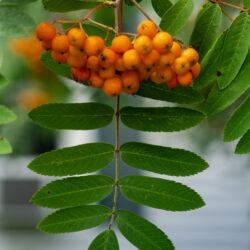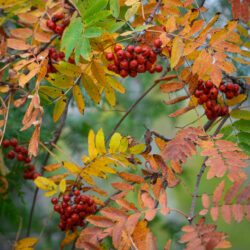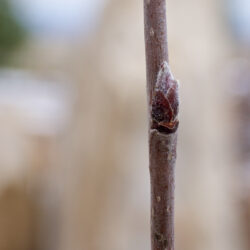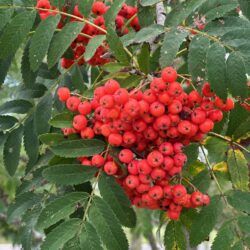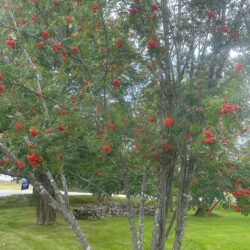Etymology
Sorbus is from the Latin name sorbum for the fruit of the service tree; americana is Latin for North or South America.
Native Habitat
Open woods and granitic outcrops.
Garden Uses
Although this plant is short-lived, it is useful as an ornamental tree due to its multi-season interest and bird attracting qualities.
Overview
Sorbus americana is a relatively small deciduous understory tree or shrub, slowly reaching 15 - 30’ in height. The crown is open and rounded. American mountain-ash grows in sun to part shade in medium to moist acidic sandy soil. As a member of the Rose family, it is subject to similar difficulties as apples, including fire blight and mildew.
Leaves and Stems
The leaves are 6 to 10” long, pinnately-compound and occur on bright orange-red or green stalks. The leaflets are lanceolate (long-oval) and are 2 - 3” long with serrated edges. In summer, the leaves are dark yellow green above and paler green underneath and they turn yellow to golden-orange and purple in the autumn. The smooth gray bark becomes scaly with age.
Flowers
Small white flowers are held in dense flat clusters that bloom in June after the leaves have emerged. Each cluster of flowers is 3”-4” across and each individual flower is about 1/8” across with 5 rounded petals.
Fruit/Seed
Broad clusters of attractive orange red berries follow the flowers. Each berry is approximately ¼” and contains light brown oblong seeds.
Wildlife Associates
The berries of American mountain ash are eaten by a wide range of small mammals and rodents. It is an important food source for resident and migrating birds. Moose and white-tailed deer frequently browse foliage, twigs and bark. Butterflies and bees are attracted to the flowers.
Propagation
Plant seed in the spring. Germination is sporadic and probably will not take place until the following spring.
Ethnobotanical Uses
The bark was used as an anti-malarial medicine by pioneer doctors because of its close resemblance to the quinine tree. The berries can be made into jellies.
Anecdotal Information
Seedlings are often seen in the forest understory - far more frequently than saplings or mature trees.
Sources
Lady Bird Johnson Wildflower Center
Plant Profile by Kathy Kling

